![]()
![]()
![]()
Use LEFT and RIGHT arrow keys to navigate between flashcards;
Use UP and DOWN arrow keys to flip the card;
H to show hint;
A reads text to speech;
15 Cards in this Set
- Front
- Back
|
What is the most common site of neoplastic growth in animals |
Skin |
|
|
Layers of the skin |
Edpidermis (outer) Superficial dermis Deep dermis Subcutis (inner) |
|
|
What are the layers of the epidermis |
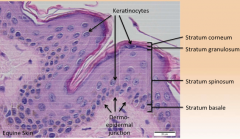
Stratum corneum (outer) Stratum granulosum Stratum spinosum Stratum basale (inner) |
|
|
3 other types of cells skin that can commonly cause neoplasia |
Melanocytes Mast cells Dendritic cells (Langerhaan cells) |
|
|
What is the job of dendritic cells |
Antigen presenting cells |
|
|
Where are mast cells commonly found |
Around blood vessels, lymphatics, and nerves |
|
|
What are the two types of glands found in the skin |
Sebaceous glands Apocrine gland |
|
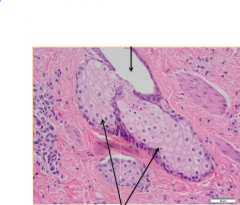
What type of gland |
Sebaceous (top arrow is pointing to lumen of follicle) |
|
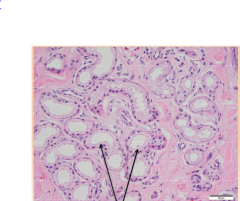
What type of gland |
Apocrine (single layer of cuboidal cells) |
|
|
What are two types of modified sebaceous glands |
Hepatoid (circumanal or perianal glands) Meibomian glands (eyelid) |
|
|
3 types of modified apocrine glands |
Ceruminous glands (external ear canal) Anal sac glands Mammary glands |
|
|
Importance of knowing which types of anal/perianal tumor you are dealing with |
Very different clinical outcome |
|
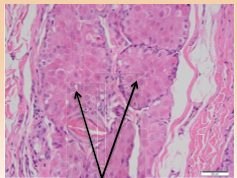
What type of gland |
Hepatoid gland |
|
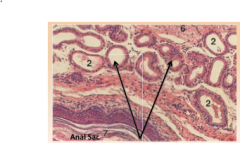
What type of gland |
Anal sac gland |
|
|
Define neoplasia |
A new growth composed of cells originally derived from normal tissue that have undergone heritable genetic changes allowing them to become unresponsive to normal growth controls and expand beyond their normal anatomic boundaries |

